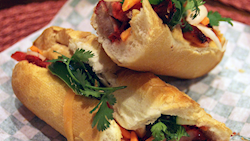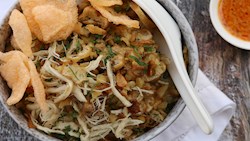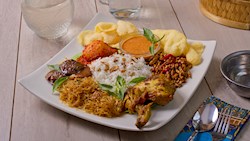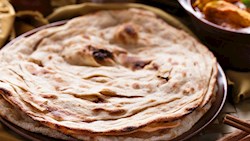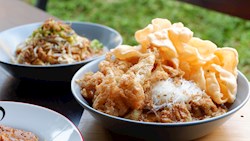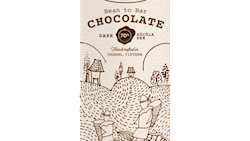Best Southeast Asian Foods
Siomay is an Indonesian dish consisting of steamed cone-shaped fish dumplings, eggs, potatoes, cabbage, tofu, and bitter melon. After they have been steamed, all ingredients are assembled on a plate, cut into bite-sized pieces, and generously drizzled with a spicy peanut sauce.
The final touch to the dish is a splash of sweet soy sauce, along with a drizzle of lime juice. Siomay is derived from Chinese shumai, and it is believed to have originated among Chinese immigrants who came to Indonesia during the Dutch colonial period.
OTHER VARIATIONS OF Dim sum
MOST ICONIC Siomay
View moreSoto Betawi is a hearty beef soup consisting of chunks of meat and offal that are slowly simmered in a coconut milk broth, which is usually enriched with various spices such as lemongrass, turmeric, galangal, kefir lime leaves, and coriander. When served, the soup is accompanied by different condiments that typically include tomatoes, scallions, sweet soy sauce, and emping crackers.
Because of its name, it is believed that the dish originated in Jakarta among the Betawi people, and today it is one of the most popular dishes in the city, usually sold at various street stalls, restaurants, or hawker-style establishments. Soto Betawi is traditionally enjoyed with steamed rice and pickled acar on the side.
OTHER VARIATIONS OF Soto
MOST ICONIC Soto Betawi
View moreMAIN INGREDIENTS
Kari ayam is a chicken curry that is popular in Malaysia and Indonesia. It is made with chicken pieces, onions, garlic, ginger, ghee, tomatoes, coconut milk, and spices such as anise, cinnamon, curry leaves, pandan leaves, lemongrass, chilis, cumin, turmeric, and fennel.
In Malaysia, kari ayam is traditionally prepared in a clay pot, because it is not reactive to the spices and allows the curry to cook in its own juices. Before serving, the dish can be sprinkled with lime juice and garnished with fresh coriander. It is recommended to serve it with rice.
OTHER VARIATIONS OF Curry
MOST ICONIC Kari ayam
View moreOne of the most famous snacks in Indonesia is batagor, a fried fish dumpling served in a traditional spicy sauce. It has roots in the Chinese culinary tradition, which has left a trace on many Indonesian dishes. Although this famous snack is reminiscent of the more famous Chinese dumpling, its distinguishable characteristic is that it is fried, not steamed.
The most common fish used to make the dish is wahoo, but tuna, mackerel, and even prawns can also be used. Potatoes, tofu, or cabbage are also occasionally added to the dish. Batagor is the perfect snack because of the way it is served. When fried, the dumplings are cut into small bite-sized pieces and covered in peanut, soy, and chili sauce with a splash of lime juice.
MOST ICONIC Batagor
View moreSate kambing is a traditional dish and a type of satay prepared with goat or mutton as the main ingredient. The meat is cut into chunks or cubes and it's marinated in a combination of ingredients such as kecap manis (sweet soy sauce), galangal, ground shallots, pineapple juice, and (often) chili peppers.
After it's been marinated, the meat is placed on skewers that are larger and thicker than the ones used for chicken satay as the texture and thickness of mutton or goat is tougher than chicken. The skewers for sate kambing are usually made from bamboo.
OTHER VARIATIONS OF Satay
MOST ICONIC Sate kambing
View moreThis beef-based version of pho is prepared with assorted cuts and parts of beef – the stock is made from beef bones, shank, ox tail, and neck, while the toppings include thinly sliced fatty brisket (gầu), flank, eye-round steak, tripe, cooked and raw beef (tái nạm), tendon (gân), or beef balls (phở bò viên), but the latter version is not that popular in Vietnam.
Beef pho is usually flavored with dried spices such as cinnamon, star anise, cloves, cardamom, and coriander. The dish is served piping hot in a bowl along with rice noodles, and it's typically topped with cilantro, sliced onions, and chopped green onions.
OTHER VARIATIONS OF Pho
Tom kha gai is Thailand's delicious national dish coming from the central part of the country and bearing the influence of neighbouring Laos. It is a soup whose name translates to boiled galangal chicken soup, consisting of coconut milk, chicken chunks or shreds, galangal (reddish-brown or pink woody plant related to ginger), lemongrass, garlic, bird's eye chili peppers, kaffir lime leaves, fish sauce, and shiitake mushrooms.
Galangal's peppery, pungent, slightly sour and floral flavors provide an interesting contrast to the creaminess of coconut milk, creating a wonderfully aromatic dish in the process. Tom kha gai is highly nutritious with great medicinal properties, such as the ability to soothe the gastro-intestinal tract.
MOST ICONIC Tom kha gai
View moreMAIN INGREDIENTS
Roti canai is a traditional pan-fried flatbread made with flour, water, eggs, and fat of Indian origin, but mainly associated with Malaysia, and surrounding countries like Indonesia, Brunei, and Thailand. The dough for roti canai is repeatedly folded, so the final product has a layered texture, a soft interior, and a crispy outer layer.
The most common fat used in roti canai is ghee, the traditional Indian clarified butter. It is believed that the dish originated in India when the Indian laborers who migrated to Malaysia brought the recipe and the tradition of preparing this crispy pastry to the foreign country.
OTHER VARIATIONS OF Roti
MOST ICONIC Roti canai
View moreThis Vietnamese classic consists of a combination of flat rice noodles and yellow egg noodles that are served with a small amount of flavorful meat broth and crispy fresh vegetables and herbs such as banana blossoms, lettuce, cilantro, scallions, and Vietnamese coriander.
The dish is incredibly versatile and usually comes topped with pork belly, chicken, shrimps, fish, boiled eggs, roasted peanuts, and fish crackers. Though it originated in Central Vietnam, more precisely the Quảng Nam Province, mì quảng is nowadays enjoyed throughout the country.
MOST ICONIC Mì Quảng
View morePerkedel are Indonesian fried delicacies consisting of either mashed potatoes, ground meat, ground corn, or minced fish (perkedel ikan). The name of these savory patties is derived from the Dutch word frikadel, showing the Dutch culinary influence on Indonesian territory.
Prior to frying, the main ingredient is usually combined with finely chopped scallions and pepper, then dipped in beaten eggs. Perkedel is traditionally served as an appetizer or a side dish with soto ayam soup, although it can also be consumed as a main dish, when it is usually accompanied by nasi kuning (yellow rice).
MOST ICONIC Perkedel
View moreBest Southeast Asian Food Producers
36 Manor is a premium tea brand located in Laos, specifically known for its Paksong teas grown on the Bolaven Plateau, a region famous for its volcanic soils and high-altitude climate. The company, under the Rongxing Group, has developed a unique approach to tea production, offering a variety of high-quality teas such as black tea, green tea, and white tea, often highlighted by their "Paksong" series.
These teas are enriched by the pristine environment of the plateau, where aged tea trees and traditional craftsmanship are key to creating distinctive, aromatic blends.
BEST Three Six Manor Teas and Herbal Infusions
PARADAi Chocolate is a chocolate producer located in Bangkok, Thailand. This company specializes in crafting single-origin Thai chocolate and is known for its commitment to bean-to-bar production. They source cocoa beans locally from different regions of Thailand, emphasizing the unique flavors of each area.
PARADAi Chocolate actively participates in the sustainable development of local agriculture by working closely with Thai farmers.
AWARDS

Academy of Chocolate - Gold
2023, 2021

Academy of Chocolate - Golden Bean
2023

Academy of Chocolate - Bronze
2024, 2023, 2022, 2021, 2020, 2019
BEST Paradai Chocolates
Auro Chocolate is a bean-to-bar chocolate company based in Taguig, Philippines, established in 2015. The company is dedicated to producing high-quality, fine cocoa and chocolate products while also focusing on sustainability and fair trade practices.
Auro Chocolate sources its cacao from local farming communities in the Philippines, supporting local farmers and their families. The company has been recognized internationally, securing various awards for its chocolate products.
AWARDS

International Chocolate Awards - Gold
2023

Academy of Chocolate - Gold
2020, 2019

International Chocolate Awards - Bronze
2023, 2019
AWARDS

ISC-International Spirits Challenge - Double Gold
2023

IWSC- International wine & spirit competition - Spirit Gold Outstanding
2024, 2023

ISC-International Spirits Challenge - Gold
2024
BEST East Asia Whisky Company Spirits
Dalareich Chocolate House is a chocolate producer based in the Philippines, specifically in Bohol. The company is involved in producing chocolate products using locally sourced cacao. They focus on bean-to-bar production, a method where the entire chocolate-making process—from roasting the cocoa beans to forming the chocolate bars—is controlled in-house to ensure quality.
Dalareich Chocolate House also engages in initiatives to support local cacao farmers by promoting sustainable agricultural practices.
AWARDS

Bartender Spirits Awards - Double Gold
2023

World Liqueur Awards - Country Winner
2024

World Gin Awards - Country Winner
2022
BEST Spice Islands Distilling Spirits
Gayo Kopi is a distinguished Indonesian company specializing in the production and export of premium Wild Kopi Luwak coffee. Their beans are sourced from the Gayo Highlands in Northern Sumatra, where wild civets naturally select and consume the finest coffee cherries.
This natural process imparts unique flavor profiles to the beans, resulting in a rich and indulgent coffee experience. Gayo Kopi is committed to ethical sourcing, ensuring that all their Kopi Luwak is collected from wild, uncaged civets, thereby supporting both environmental sustainability and animal welfare.
BEST Gayo Kopi Coffees
AWARDS

IWSC- International wine & spirit competition - Spirit Gold
2024

IWSC- International wine & spirit competition - Spirit Gold Outstanding
2024
BEST Sangsom Distillery Spirits
AWARDS

SFWSC - San Francisco World Spirits Competition - Double Gold
2024

ISC-International Spirits Challenge - Gold
2021

ISC-International Spirits Challenge - Gold trophy
2020
BEST 53 degrees enterprise Spirits
AWARDS

SFWSC - San Francisco World Spirits Competition - Double Gold
2024
BEST Lady Trieu Spirits
Best Southeast Asian Food Products
AWARDS

SFWSC - San Francisco World Spirits Competition - Double Gold
2024, 2023

SWSC - Singapore World Spirits Competition - Double Gold
2023

The Gin Masters - Gold
2022
PARADAi Chocolate's Dark 70% - Peru, Chuncho is a premium dark chocolate made exclusively from Chuncho cocoa beans sourced from Peru. This product is renowned for its deep, complex flavor profile featuring notes of dark berries, nuts, and a hint of floral undertones, which are characteristic of Chuncho cocoa.
The richness and balance of the chocolate are enhanced by the meticulous bean-to-bar process that PARADAi Chocolate employs, ensuring each bar maintains the highest quality and authenticity. The 70% cacao content strikes a perfect balance between intensity and smoothness, appealing to both dark chocolate aficionados and newcomers alike.
AWARDS

Academy of Chocolate - Gold
2023

Academy of Chocolate - Golden Bean
2023
AWARDS

IWSC- International wine & spirit competition - Spirit Gold Outstanding
2024

ISC-International Spirits Challenge - Gold
2024
The product 42% Milk Hojicha made by Auro Chocolate is a sophisticated blend that combines the rich flavors of roasted green tea (Hojicha) with creamy milk chocolate. Auro Chocolate, renowned for its high-quality bean-to-bar products, ensures a harmonious balance between the roasted notes of Hojicha and the smoothness of milk chocolate.
This particular product exemplifies Auro’s dedication to creating unique and refined flavors, utilizing sustainably sourced cacao beans. The result is a unique chocolate experience that brings out the nuanced flavors of both the tea and the chocolate.
AWARDS

International Chocolate Awards - Gold
2023
Auro Chocolate's 50% Dark Milk Chocolate Vetiver with Freeze Dried Pineapple and Rice Crispies is a product that blends distinct flavor profiles and textures. The chocolate is a premium offering made by Auro Chocolate, a company renowned for its bean-to-bar approach, ensuring high-quality and ethically sourced ingredients.
This particular bar combines the depth of 50% dark milk chocolate with the aromatic notes of vetiver, a fragrant grass with a slightly woody and earthy scent. The inclusion of freeze-dried pineapple adds a sharp, tangy sweetness, while the rice crispies provide a delightful crunch, creating a complex yet harmonious tasting experience.
AWARDS

Academy of Chocolate - Gold
2020
Auro Chocolate produces a unique product known as 64% Dark Chocolate with Ylang Ylang and Roasted White Chocolate. This artisanal chocolate bar combines the robust flavors of 64% dark chocolate with the floral and aromatic notes of ylang-ylang, creating a complex and luxurious taste experience.
In addition to the dark chocolate and ylang-ylang, this bar is complemented by the richness of roasted white chocolate, adding a creamy and slightly caramelized dimension to the overall flavor profile. The combination aims to offer a distinctive and indulgent treat for chocolate enthusiasts.
AWARDS

Academy of Chocolate - Gold
2020
Auro Chocolate's 32% White Davao Origin is a high-quality white chocolate product. The chocolate is crafted from cacao sourced directly from Davao, a renowned cacao-growing region in the Philippines, known for its rich and diverse flavors. This artisanal chocolate showcases Auro's commitment to ethical sourcing and sustainable practices.
The 32% cocoa content offers a balanced flavor profile that is less sweet than typical white chocolates, appealing to both traditional white chocolate lovers and those seeking a more nuanced experience.
AWARDS

Academy of Chocolate - Gold
2020
AWARDS

Academy of Chocolate - Gold
2021
Auro Chocolate's 100% Cacao Unsweetened Chocolate is crafted from high-quality cacao beans sourced directly from Filipino farmers. The chocolate boasts a pure, intense cocoa flavor with no added sugars or artificial ingredients, making it ideal for baking, cooking, or enjoying as a robust snack.
The product undergoes meticulous processing to ensure the retention of natural flavors and nutritional benefits typically associated with pure cacao. Auro Chocolate emphasizes sustainability and ethical sourcing practices, contributing to the welfare of local farming communities.
AWARDS

Academy of Chocolate - Gold
2019
AWARDS

Academy of Chocolate - Gold
2017
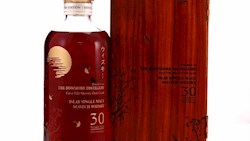





TasteAtlas food rankings are based on the ratings of the TasteAtlas audience, with a series of mechanisms that recognize real users and that ignore bot, nationalist or local patriotic ratings, and give additional value to the ratings of users that the system recognizes as knowledgeable. For the “Top 100 Southeast Asian Foods” list until March 27, 2025, 31,880 ratings were recorded, of which 21,028 were recognized by the system as legitimate. TasteAtlas Rankings should not be seen as the final global conclusion about food. Their purpose is to promote excellent local foods, instill pride in traditional dishes, and arouse curiosity about dishes you haven’t tried.











